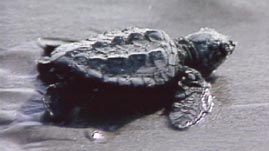Teachers' Domain - Digital Media for the Classroom and Professional Development
User: Preview

Source: Texas Parks and Wildlife Department
In this video adapted from Texas Parks and Wildlife Department, learn about the conservation efforts that are helping to bring a species of sea turtle back from the brink of extinction. Although human-caused environmental degradation has been rampant in recent centuries, the scientists and volunteers featured in this video show that conservation efforts can and do succeed.
Sea turtles are an evolutionary success story if ever there was one. Physical and behavioral adaptations have enabled these large, long-lived reptiles to exploit nutrient-rich coastal waters so effectively that they have survived virtually unchanged for 150 million years. They have endured countless geological and climatic events, including the shift that brought the dinosaurs to their demise. In a remarkable change of fate, however, human activities have pushed the seemingly eternal sea turtles close to extinction, all in an astonishingly short period of time.
Humans' exploitation of the rich coastal waters and undisturbed beaches that have historically enabled sea turtles to be so successful has caused sea turtle numbers to drop dramatically in the last 100 years. By the end of the 20th century, all seven existing sea turtle species were classified as either threatened or endangered. One species, the Kemp's ridley sea turtle, has been hit the hardest. In 1947, observers documented as many as 40,000 female Kemp’s ridley sea turtles nesting on a single beach in Mexico in just one day. By the late 20th century, fewer than 5,000 individuals (2,500 females) remained worldwide.
The causes of the precipitous decline of this and other sea turtle species are varied, but all have a human component. Commercial development along beaches where turtles lay their eggs has been particularly devastating. Not only has this activity reduced available nest sites, it has also introduced artificial lighting that deters egg-bearing females from coming ashore, and also disorients hatchlings as they leave the nest and attempt to make their way to the water. Both on land and at sea, humans have also taken a direct toll on sea turtle numbers. They have hunted them both for their meat and for their shells, and have collected their eggs. Vast numbers of sea turtles have also been caught and accidentally drowned in fishing nets pulled by trawlers.
International conservation efforts have sought to eliminate or mitigate the effects of human activities on sea turtles, and in recent years have begun to slow, and in some cases reverse, the precipitous decline of their populations. Regulations are a key component to these small strides, but so is the improvement of sea turtle nesting opportunities. One such project has introduced Kemp's ridley sea turtles to the beaches of South Padre Island, off the coast of Texas in the Gulf of Mexico. The hope is that these beaches will help to replace nest sites that have been lost elsewhere. And thanks to the sea turtle's propensity to nest on the beaches where they hatched, the plan seems to be working. During the 2006 nesting season, biologists found 100 Kemp's ridley nests on South Padre Island and along other Texas coastlines, double the number found just one year before.
 Loading Standards
Loading Standards Teachers' Domain is proud to be a Pathways portal to the National Science Digital Library.
Teachers' Domain is proud to be a Pathways portal to the National Science Digital Library.
